
Summary of Agency Chief Foia Officer Reports with Findings and Oip Guidance for Improvement
Introduction
This Spring marked the first time that agencies submitted to the Department of Justice Chief FOIA Officer Reports describing the steps taken by each agency to improve FOIA operations and facilitate information disclosure. The Attorney General required submission of these reports as part of his new FOIA Guidelines issued on March 19, 2009. The Office of Information Policy (OIP) has conducted a comprehensive review of all ninety-four Chief FOIA Officer Reports and has prepared this summary. Included in the summary are OIP's findings and guidance to agencies on the next steps that should be taken so that even greater transparency can be achieved in the year ahead.
President Obama's FOIA Memorandum
In an unprecedented action that signaled his commitment to the ideals of transparency and openness, President Obama, on his first full day in office, issued a Memorandum to the heads of all Executive Branch Departments and agencies calling on them to "renew their commitment to the principles embodied in FOIA." The President directed all agencies to administer the FOIA with a clear presumption in favor of disclosure, to resolve doubts in favor of openness, and not to withhold information based on "speculative or abstract fears."
Moreover, the President called on agencies to ensure that they respond to requests in "a spirit of cooperation," that disclosures are made timely, and that modern technology is used to make information available to the public even before a request is made. To carry out these responsibilities, the President directed the Attorney General to issue new guidelines governing the FOIA.
Attorney General Holder's FOIA Guidelines
In accordance with the President's directive, on March 19, 2009, Attorney General Holder issued new FOIA guidelines which called on all agencies to reaffirm the government's "commitment to accountability and transparency." The FOIA Guidelines stress that the FOIA is to be administered with the presumption of openness called for by the President. The Attorney General strongly encouraged agencies to make discretionary disclosures of information. He also directed agencies not to withhold information simply because they may do so legally. He also directed agencies to consider making partial disclosures when full disclosures are not possible.
In his FOIA Guidelines, the Attorney General went beyond addressing the principles applicable to applying the presumption of openness. He also comprehensively addressed the need for each agency to establish an effective system for improving transparency. In doing so, he emphasized that "[e]ach agency must be fully accountable for its administration of the FOIA."
Preparation of Chief FOIA Officer Reports
The Attorney General emphasized that "[i]mproving FOIA performance requires the active participation of agency Chief FOIA Officers." Accordingly, the Attorney General directed agency Chief FOIA Officers to review "all aspects of their agencies' FOIA administration" and to report each year to the Department of Justice on the steps taken "to improve FOIA operations and facilitate information disclosure."
The Attorney General charged OIP with responsibility for providing guidance to agencies on the timing and content of Chief FOIA Officer Reports to the Attorney General. Those guidelines were issued by OIP on September 30, 2009. Based on the principles contained in the President’s Memorandum on the FOIA and the Attorney General’s FOIA Guidelines, OIP asked agencies to report on the steps taken to achieve greater transparency in five distinct areas. Those five areas were: 1) the presumption of openness; 2) effective systems for responding to requests; 3) proactive disclosures; 4) use of technology; and 5) backlog reduction.
Set out below is OIP’s analysis and summary of the content of agency Chief FOIA Officer Reports. There are a few points to keep in mind when reviewing this summary. Each agency’s Chief FOIA Officer Report contains individualized descriptions and often many details about that agency’s FOIA administration. All agency Chief FOIA Officer Reports are linked together on OIP’s website at http://www.justice.gov/oip/reports.html and can be easily compared and reviewed on that site. In compiling this summary, we necessarily had to choose a discrete number of examples to illustrate agency activities, but for every example included there are many more contained within the agency Reports themselves. Finally, for those agencies that utilize decentralized systems for processing FOIA requests, when a majority of the components for a given agency responded affirmatively to a question, the agency was included in the tally of affirmative responses.
Section I. Steps Taken to Apply the Presumption of Openness
The guiding principle underlying the President's FOIA Memorandum and the Attorney General's FOIA Guidelines is the presumption of openness. To assess the degree to which this presumption was applied by agencies and to measure the level of its impact in the first year of implementation, OIP required agencies to report two separate elements in Section I of their Chief FOIA Officer Reports. First, agencies were asked to describe the steps taken to ensure that the presumption of openness is being applied to all decisions involving the FOIA. This was a comprehensive reporting element where agencies could describe a range of activities, from publicizing the President's FOIA Memorandum and the Attorney General's FOIA Guidelines, to implementing the presumption when processing documents responsive to FOIA requests and administrative appeals. Agencies were asked to provide examples illustrating agency action in making discretionary releases of records.
The second reporting element required agencies to provide statistics. Specifically, agencies were asked to report whether there were increases in the number of responses where records were released in full or where records were released in part when compared with those numbers in the previous year's Annual FOIA Reports. In conjunction, the responses to these two elements have provided both a description of how agencies are applying the presumption of openness and a measurement of its impact on agencies' responses to FOIA requests.
A. Steps Taken to Apply the Presumption of Openness
OIP first examined agencies' Chief FOIA Officer Reports to assess the degree to which each agency had disseminated the President's and the Attorney General's message of openness to agency personnel. Many Chief FOIA Officers reported completing similar steps to ensure that agency personnel received the message. Commonly reported steps included distributing the President's FOIA Memorandum or the Attorney General's FOIA Guidelines, creating agency specific guidance, attending training, or providing agency-specific training. As the chart below indicates, almost all agencies distributed the President's Memorandum or the Attorney General's FOIA Guidelines. More than half attended or provided training on applying the presumption of openness. For example, the Department of Labor held a two-day FOIA conference, attended by nearly three hundred FOIA professionals, which included a session specifically focused on the President’s and Attorney General’s new presumption of openness. The Department of Labor also developed a webinar for all of its attorneys who have FOIA-related responsibilities, conducted quarterly FOIA meetings in-house, and attended FOIA training provided by the Department of Justice.
Other agencies issued guidance on applying the presumption. For example, DHS issued guidance to its many components, stressing the importance of transparency and emphasizing the importance of making proactive disclosures. While larger FOIA programs are more likely to issue their own guidance to reach their many different components, smaller agencies, such as the NRC and the Office of Special Counsel, have found it beneficial for their agencies to issue internal guidance that addresses the complex problems unique to those offices.
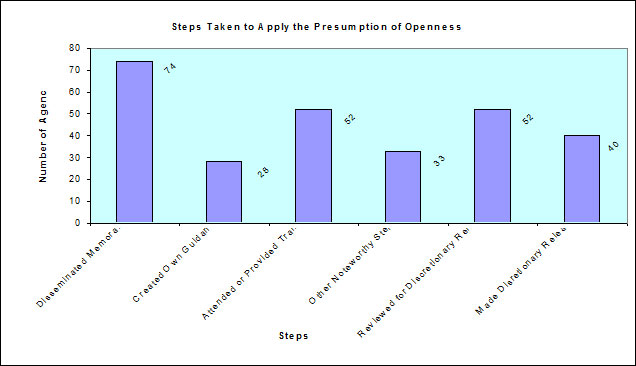
In addition to these more common steps, thirty-three agencies reported taking additional, agency-specific steps to ensure that the openness message was received. The effort shown by these agencies demonstrated a commitment to tailor the message of openness in order to overcome hurdles unique to those agencies. For instance, SBA and the IRS added language to inter-office communications, such as search memoranda or referral memoranda, to remind personnel in the program offices of the obligation federal agencies have to be more transparent. SSA created internal working groups to help tackle specific FOIA issues that arise while processing their records. Along these same lines, the Department of the Interior has created an "Open Government Core Team," and the Institute of Museum and Library Services has created an "Open Government Task Force" to help implement changes that will increase transparency.
Several agencies have changed their document review processes to help ensure that the proper level of transparency is being considered by agency personnel. For example, the Department of Commerce now requires a senior official to certify that a foreseeable harm analysis has been applied to responsive documents. Also, the Department of Education has established a two-level "quality review" of documents that are not initially recommended for full release. This second-level review involves agency personnel examining the documents a second time to ensure that the foreseeable harm standard has been used and that all reasonably segregable information is released. HHS, Centers for Disease Control (CDC) now uses subject matter experts in their review of documents in order to determine if more material can be released as a matter of agency discretion.
Further, more than half of the Chief FOIA Officers reported that they were taking steps to ensure that agency personnel were reviewing documents for discretionary release.
FINDINGS AND OIP GUIDANCE FOR IMPROVEMENT
1. There are many good examples of agency initiatives designed to implement the President's call for a presumption of openness. Many agencies have actively embraced the new FOIA Guidelines and aggressively made changes, taking steps to ensure that their agencies were applying the presumption of openness. Indeed, more than half of the agencies reported what can fairly be viewed as remarkable progress in this area. For those agencies, their Chief FOIA Officer Reports revealed many examples of steps taken to apply the presumption of openness which demonstrated that the agencies were fully engaged in implementing the new transparency guidelines. To make the President’s and Attorney General’s goals a reality across the government, all agencies must ensure that they employ active, aggressive approaches to improving transparency at their agencies.
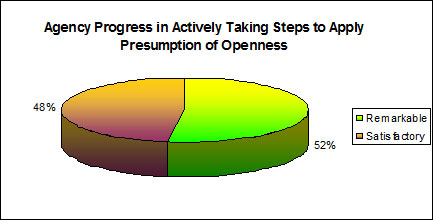
2. A fundamental step that agencies can take to improve transparency is to ensure that over the course of the coming year agency personnel both attend training on the new FOIA guidelines and the presumption of openness and provide such training to key personnel within their agencies. Throughout the year there are numerous training opportunities provided by OIP for agency personnel to attend. In addition, OIP provides specialized training to individual agencies on applying the presumption of openness. While fifty-two of the ninety-four agencies subject to the FOIA reported that their personnel attended training or provided their own training, that figure should be much higher. In order to ensure that every agency is applying the presumption of openness correctly, each agency should require that its personnel, both FOIA and non-FOIA, attend training so they understand the President's message and the Attorney General's FOIA Guidelines on transparency.
3. Agencies should offer guidance that is tailored to the type of records they typically process in response to FOIA requests. Following issuance of the Attorney General's FOIA Guidelines, OIP distributed comprehensive guidance to all agencies on applying the presumption of openness, making discretionary disclosures, establishing systems to identify information for proactive release, and improving timeliness. See http://www.justice.gov/oip/foiapost/2009foiapost8.htm. While many agencies supplemented OIP’s guidance with agency-specific directives, all agencies should consider doing so in order to tailor their directives or guidance to address their own agency concerns and obstacles.
B. Discretionary Disclosures
In Section I of their Chief FOIA Officer Reports agencies were asked to include examples or statistics illustrating their action in making discretionary releases of records or portions of records. OIP found that fifty-two of the ninety-four agencies subject to the FOIA reported that they reviewed records for discretionary release.
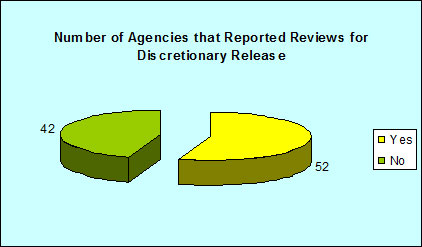
Those agencies that reported conducting this review also reported concrete results. Of the fifty-two agencies that reviewed their documents for discretionary release, thirty-nine reported making discretionary releases.

This strong correlation demonstrates that the agencies that took the time to review their documents with a presumption of openness in mind were able to identify additional information that could be released. These additional releases are at the heart of increased transparency.
OIP also examined the type of discretionary releases made by agencies. As explained in OIP's guidance issued on April 17, 2009, documents protected by Exemptions 2, 5, 7, 8, and 9 can all be the subject of discretionary release, but Exemption 5 holds the most potential for increased releases. Not surprisingly, agency Chief FOIA Officer Reports showed that discretionary releases were most frequently made of material that fell within the parameters of Exemption 5. Secondly, information that could be protected by Exemption 2 was also released as a matter of discretion. In addition, agencies cited releasing Exemption 7 material as a matter of discretion.
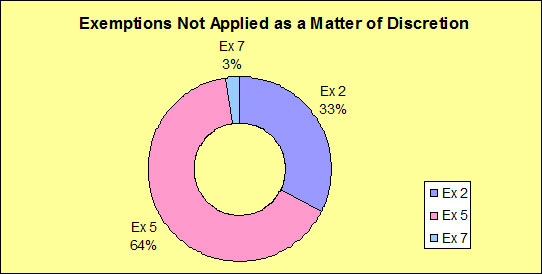
FINDINGS AND OIP GUIDANCE FOR IMPROVEMENT
Agencies should institute a system, or add a step in their processing procedures, to affirmatively consider whether more information can be released as a matter of administrative discretion. The data compiled in the Chief FOIA Officer Reports reveals that when agencies took the time to affirmatively consider whether additional material could be released in response to a request, there was a corresponding increase in the number of discretionary releases made. To ensure that this review is undertaken, each agency should consider adding a distinct step in its processing procedures to consider whether additional material can be disclosed. This step should be employed at both the initial review level and on administrative appeal.
C. Increased Releases in Full or in Part
Lastly, in Section I of their Chief FOIA Officer Reports, agencies were asked to report whether they had increased the number of responses where records were released in full or where records were released in part in Fiscal Year 2009 as compared to Fiscal Year 2008. Overall, departments and agencies combined provided partial grants of requested records for nearly 170,000 requests in Fiscal Year 2009. This is an increase of approximately fifty thousand partial grants of access as compared with Fiscal Year 2008. This is a significant achievement.
When OIP examined the statistics for full releases, however, there was a decline in the number. In Fiscal Year 2009, a combined total number of 215,124 full releases were made. This is a decrease of roughly 45,000 as compared with Fiscal Year 2008. Still, the increase in the number of partial releases was significant enough that when full and partial releases were combined, there was an increase in the number of overall responses where records were released.
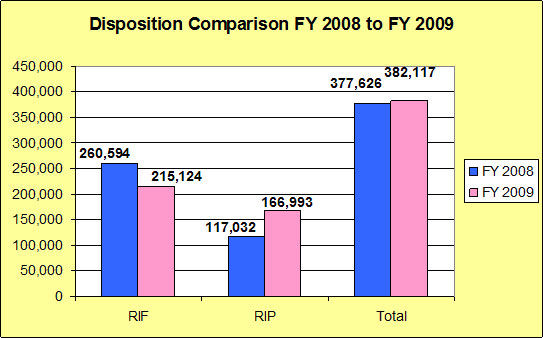
For a more complete analysis, OIP also examined the response totals at each agency. Sixty-one agencies, which is just under two-thirds of the ninety-one agencies subject to the FOIA in both fiscal years1, reported an increase in either the number of full releases or partial releases in Fiscal Year 2009. Of these agencies, fifty-two had an increase in partial releases while forty had an increase in the number of full releases. Thirty-one agencies were able increase both their number of full releases and their number of partial releases.
Several agencies reported significant improvement in the numbers of releases made. DHS, for example, had an increase in both releases in full and releases in part by over 5000 requests, and DOJ had increases in both releases in full and releases in part by over 800 requests.
In general, though, while many agencies were able to report increases in these numbers, for the vast majority the size of the increase was modest. Only fourteen agencies increased the number of full release responses by over fifty in Fiscal Year 2009, and only seventeen agencies were able to increase the number of partial releases by over fifty.
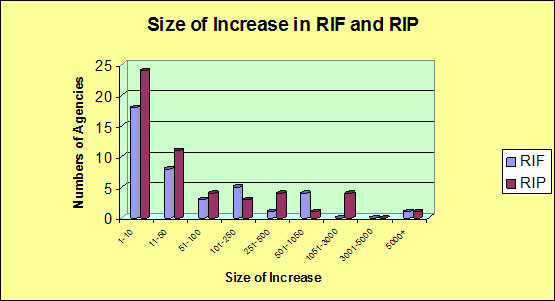
FINDINGS AND OIP GUIDANCE FOR IMPROVEMENT
Overall, agencies made real progress in increasing the number of requests where records were released, particularly the number where records were released in part. Such increases are an important indicator of increased transparency and agencies have made concrete progress in this regard. Still, there is room to improve. There are some agencies that had decreases in the number of full or partial releases and several only had modest increases. The number of full releases made by agencies logically will drop as those agencies proactively post documents that previously were available only by request and which were released in full when requested. The proactive disclosures eliminate the need for making requests, but they correspondingly have the effect of reducing the number of full grants that the agency otherwise would make. Still, agencies should strive to increase the number of requests where records are released. Chief FOIA Officers, as well as other agency FOIA professionals, should regularly track the number of full and partial releases made throughout the year to ensure that sufficient focus is being paid to this issue. With each request that has responsive documents that are being processed, agencies should be asking if a document that would typically be withheld in full could in fact be released in part. Likewise, for each document that would typically be released in part, agencies should be asking if the document could in fact be released in full. The active attention by each agency to the disposition given in response to all FOIA requests will help ensure that every agency becomes more transparent each year.
Section II: Steps Taken to Ensure that Each Agency has an Effective System for Responding to Requests
In Section II of their Chief FOIA Officer Reports, OIP asked agencies to describe the steps they had taken to ensure that they had effective systems in place to respond to requests. As the Attorney General emphasized in his FOIA Guidelines, “[a]pplication of the proper disclosure standard is only one part of ensuring transparency. Open government requires not just a presumption of disclosure, but also an effective system for responding to FOIA requests.” In particular, OIP asked agencies to report on the steps taken to ensure that they had sufficient IT support for their FOIA responsibilities.
A. IT Support
In response to the question regarding IT support, seventy agencies reported that they did have sufficient support from their IT personnel. Only three agencies affirmatively reported insufficient IT support, while twenty-one did not address the issue.
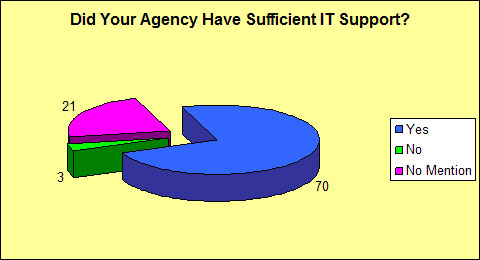
IT support is critical to FOIA operations and greatly enhances the ability of agencies to improve transparency. For example, the Board of Governors of the Federal Reserve System reported that it had considerable IT support, which enhanced the ability of its FOIA staff to compile and review a substantial number of records pertaining to the financial crisis.
FINDINGS AND OIP GUIDANCE FOR IMPROVEMENT
The response to this question reveals that there has been a significant improvement in coordination between FOIA professionals and IT personnel. As the Attorney General noted in his FOIA Guidelines in March 2009, in prior years agencies had noted that insufficient IT support had hindered their ability to implement their FOIA Improvement Plans made under Executive Order 13392 of December 14, 2005. With seventy agencies now reporting that they do have sufficient IT support, this is clearly no longer the concern that it once was. Still, for those remaining agencies for which this is a problem, the Chief FOIA Officer should take steps to ensure that agency IT personnel are fully supporting their FOIA professionals.
B. Upgrading IT Tools
Agencies reported taking a wide variety of steps to ensure that their systems for responding to FOIA requests are efficient and effective. For example, thirty-nine agencies reported that they took steps to procure or upgrade their IT tools.
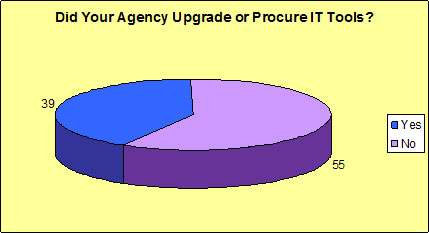
The Department of State is one of the agencies that reported doing so. At the request of its Chief FOIA Officer, State has committed $700,000 to transition to a newer, more advanced electronic case tracking and processing system. Similarly, HHS, Centers for Medicare and Medicaid Services implemented an electronic FOIA request management and tracking system in both its headquarters and its ten regional offices. The Merit System Protection Board made several upgrades to its FOIA tracking system, which allows for faster responses to status inquiries and provides better monitoring. Those upgrades included working with the agency’s IT department to capture incoming requests and subsequent agency responses in one agency-wide document management system. Similarly, NASA implemented an agency-wide FOIA tracking system which allows use of electronic redaction tools and simplifies compilation of its Annual FOIA Report.
As is discussed below in Section IV, agencies overwhelmingly embrace the use of technology to assist them in receiving, tracking, and processing requests, as well as in preparation of their Annual FOIA Reports. Given the extensive utilization of technology in the FOIA process, it is not surprising that thirty-nine agencies reported that they upgraded or procured additional IT tools to assist in their efforts.
C. Active Chief FOIA Officers
The Chief FOIA Officer at each agency obviously plays a critical role in ensuring that the agency has an effective system in place to respond to requests. For those agencies that reported the active involvement of their Chief FOIA Officers, that involvement was linked to the existence of sufficient IT support, increases in staff, and enhanced cooperation with non-FOIA personnel. There were many examples given in the Reports of active Chief FOIA Officers.
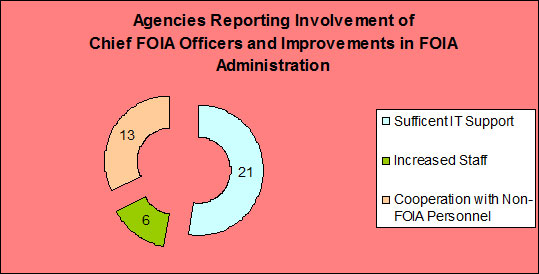
For example, HUD’s Chief FOIA Officer regularly receives updates on FOIA-related issues. The Chief FOIA Officer at Department of Transportation directed every component to conduct a review of its FOIA program and then met with senior level officials of that component to discuss component-specific recommendations. Smaller agencies reported the direct involvement of their Chief FOIA Officers with day-to-day FOIA operations. For example, the Chief FOIA Officer for the Federal Mine Safety and Health Review Commission works directly on all FOIA requests received there and is responsible for the agency's website content. The Postal Regulatory Commission Chief FOIA Officer likewise is directly involved in FOIA request handling.
At the Department of Justice, the Associate Attorney General is the Chief FOIA Officer, making him the highest ranking Chief FOIA Officer in the government. He is actively involved not only in the Department's FOIA activities, but in encouraging all agency Chief FOIA Officers to improve FOIA performance and increase transparency.
FINDINGS AND OIP GUIDANCE FOR IMPROVEMENT
The importance of the Chief FOIA Officer cannot be overstated. By law, each of these officials is responsible for ensuring that their agency efficiently and effectively complies with the FOIA. They are also each charged with responsibility for making recommendations to the head of their agency on any necessary adjustments to agency practices, policies, personnel, and funding as may be necessary to improve implementation of the FOIA. All agencies should ensure that their Chief FOIA Officer is of sufficiently high level within the agency and has sufficient authority to be able to carry out these statutory duties.
D. Commonly Cited Steps for Improving Effectiveness
OIP looked for other common trends among agencies in the steps taken to ensure that they had effective systems in place for responding to requests. In addition to mentioning the involvement of their Chief FOIA Officers, and improving their IT capacities, other examples listed by agencies as steps taken to improve their effectiveness and efficiency include conducting regular reviews of pending FOIA cases, increasing staff, improving customer service, and working more closely with non-FOIA personnel.
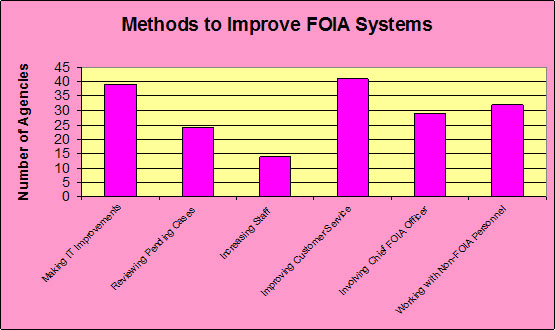
1. Conducting Regular Reviews of Pending FOIA Cases
Several agencies reported instituting procedures to regularly review pending FOIA requests as one of the steps employed to create an effective FOIA system. For example, the Department of Energy initiated monthly conference calls between Departmental FOIA Officers during which individual cases and the overall FOIA process are discussed. HHS, OIG conducts weekly reviews of all open FOIA requests. The Commodity Futures Trading Commission likewise has assembled a team to meet weekly to review the status of pending requests and brainstorm over issues that arise. SSA now assigns specific due dates for coordinators and established rigorous follow-up procedures. SSA also elevates issues to senior agency officials when necessary and has found that these procedures are speeding up processing.
2. Increasing Staff
Increasing the number of FOIA staff is a logical improvement to the FOIA process. Fourteen agencies mentioned doing so. For example, the Department of Justice, National Security Division hired a new FOIA professional and announced the creation of two additional new positions. The Broadcasting Board of Governors, Office of General Counsel increased the number of staff who handle FOIA issues from one employee who worked on requests part-time, to five employees who work on requests part-time. Each of those professionals received formal training on FOIA, including the presumption of openness. ODNI hired an additional full-time professional to work on FOIA issues and is in the process of filling a second such position.
3. Improving Customer Service
Improving customer service is yet another aspect of ensuring that each agency has an effective system in place for responding to requests. This issue is of such importance that OIP recently issued guidance to agencies on this topic. See http://www.justice.gov/oip/foiapost/2010foiapost5.htm. OIP’s guidance addressed the importance of agencies providing requesters with contact information; discussing with them the scope of their requests; providing interim releases; and limiting “still interested” letters. In their Chief FOIA Officer Reports, many agencies reported that they routinely contact requesters to discuss the scope of their requests. Several agencies, including DHS, DOD, and NASA reported that they had established online tools for requesters to use to access information pertaining to the status of their requests. The Department of Energy reported that it had emphasized the importance of customer service in its FOIA training. The Department of Agriculture is expanding its FOIA Requester Service Center, which serves as its focal point for incoming requests.
4. Working with Non-FOIA Staff
Agencies also took steps to either utilize non-FOIA staff or to more fully integrate them into FOIA operations. For example, the Department of Commerce has identified staff members assigned to non-FOIA programs who are available to assist the FOIA office during peak workload periods. At DOD, the Defense Threat Reduction Agency has designated a FOIA point of contact for each of its Directorates to facilitate document searches and to ensure timely responses. Similarly, the Department of Labor, Employee Benefits Security Administration has assigned an additional FOIA point of contact in each office to facilitate prompt response to FOIA requests. The Chemical Safety and Hazard Investigation Board worked with its Information Management Staff to integrate FOIA processing directly into the agency's electronic records management program, rather than using a stand-alone electronic FOIA processing system. The new capability to review records in their native format should enhance the efficiency and effectiveness of the Board's system for responding to requests.
5. Improving Search Capabilities
Eighteen agencies mentioned improving search capabilities as a step they had taken toward achieving greater efficiency. For example, EPA collaborated with its IT staff to device a method to search for responsive e-mail records using key word searches. The Merit System Protection Board made several upgrades to its document management system and now FOIA personnel have direct access to the records they need and do not have to wait for program staff to provide them access. The Surface Transportation Board worked with its IT staff to develop staff instructions for performing more thorough and efficient electronic searches of e-mail and hard drives. Other agencies reported designating search points of contact and establishing procedures for conducting searches.
FINDINGS AND OIP GUIDANCE FOR IMPROVEMENT
Agencies are utilizing a wide range of approaches to make their FOIA systems effective and efficient. Agencies will find it beneficial to review the Chief FOIA Officer Reports of other agencies to look for ideas and approaches that would be beneficial. To assist agencies, OIP has compiled a list of Best Practices that incorporates many of the examples provided in Chief FOIA Officer Reports. All agencies should review that list and strive to incorporate as many of those Best Practices as practicable in order to realize increased efficiency and effectiveness at their agencies.
Section III: Steps Taken to Increase Proactive Disclosures
President Obama declared that the presumption of disclosure “means that agencies should take affirmative steps to make information public” and to “use modern technology to inform citizens about what is known and done by their Government.” In his FOIA Guidelines, Attorney General Holder directed agencies to “readily and systematically post information online in advance of any public request.” For Section III of their Chief FOIA Officer Reports, OIP asked agencies to describe the steps they have taken to increase proactive disclosures of information and to provide examples of material newly made available on agency websites.
A. Increasing Postings on Agency Websites
Agencies across the government have fully embraced the concept of proactively disclosing information. Indeed, eighty-four agencies reported that they had added material to their websites since issuance of the new transparency guidelines.

Of those eighty-four agencies, fifty-one reported that they were posting program material. For example, the Department of Education is in the process of posting 33,000 pages regarding its “Race to the Top” program. The Forest Service has placed over 30,000 publications and technical reports online. The Department of Transportation, FAA is posting its National Wildlife Strike database. The Department of the Treasury is posting multiple documents online connected with the economic recovery effort. EPA is posting tens of thousands of pesticide records. DOD is posting contracts, grants, and reports. DHS is posting Congressional correspondence. AMTRAK has created a website which contains certain contracting information connected with the American Recovery and Reinvestment Act of 2009. The Farm Credit System Insurance Corporation has created and posted an “Investment Portfolio” page, a “Laws and Regulations” page, and an “Insurance Premiums” page, all detailing that agency’s programs.
Twelve agencies reported posting responses to FOIA requests. For example, the Department of Justice, Criminal Division is in the process of posting historically significant records pertaining to high-profile cases, such as records pertaining to “Tokyo Rose” and “AXIS Sally.” The Department of Energy posted copies of FOIA requests received in 2009 with their corresponding releasable records. DHS posts its FOIA logs, as do components of the Department of Justice.
Eight agencies reported posting the schedules of high level officials. For example, the Department of State posts a Daily Appointment Schedule for the Secretary of State. Other agencies post schedules relating to upcoming events, such as the TVA which posts a calendar of Board meetings, and the NTSB which posts estimated release dates for its investigations.
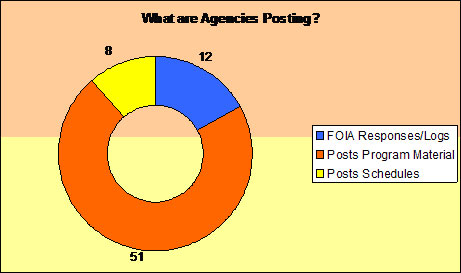
FINDINGS AND OIP GUIDANCE FOR IMPROVEMENT
The area of proactive posting is clearly one which shows marked success by an overwhelming number of agencies. As can be seen by the examples given here, a wide range of materials are being posted. Nevertheless, there were some agencies, or components of agencies, that failed to report any significant new postings. Instead, a few agencies merely cited the posting of “frequently requested” records, or Annual FOIA Reports, which are already legally required to be posted, or gave only general language regarding plans to review records for proactive release. Given the importance to the public of being able to readily review online the vast quantity and variety of materials generated or obtained by agencies, every agency should exponentially increase the amount of material available on its website. In doing so, they will be abiding by the President's and Attorney General's call to proactively disclose information to the public without waiting for individualized requests.
B. Establishing Systems to Identify Records for Posting
Forty agencies reported that they had established systems to identify records for posting, while fifty-four agencies made no specific mention of having such systems.
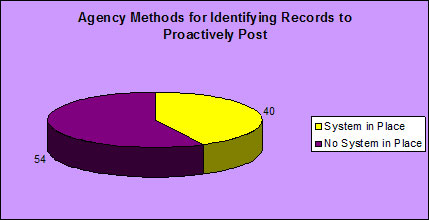
This is quite significant, because using a systematic, rather than an ad hoc approach to proactive disclosures greatly enhances the value of the information posted. There were several examples given in the Chief FOIA Officer Reports of systems for identifying records for posting. For example, DOD gets input from the public on its open.gov website as to what types of documents the public would like to see posted. HUD designated a FOIA Specialist to work with program staff in the agency to identify records to post. The Department of State established a full-time position for a Web Content Manager of the FOIA website.
Other agencies reported engaging a wide spectrum of agency personnel in the search for records to proactively disclose. For example, the Chief FOIA Officer of DHS directed a wide-range of proactive disclosures across the agency. The Departments of Justice and Education worked directly with program offices to post documents. The National Highway Traffic Safety Administration assigned staff to monitor activity within program offices to identify documents for posting.
FINDINGS AND OIP GUIDANCE FOR IMPROVEMENT
The vast majority of agencies have embraced proactive disclosures and are significantly increasing the amount of material made available on their websites. As mentioned above, though, there is a gap with some agencies or components of agencies failing to post more than the statutory minimum. All agencies should ensure that they, including all their components, are identifying documents for proactive disclosure and have an on-going process of posting documents of interest to the public. To be successful, this agency-wide process should encompass a team of personnel, including FOIA professionals, IT personnel, and program office officials, who can collectively identify records appropriate for posting.
C. Enhancing the Quality of Posted Information
In addition to making more information available to the public on agency websites, agencies also reported different ways in which they were enhancing the quality or usability of the data. The TSA, for example, created a Claims Management Database that allows the tracking of lost or stolen items. The Department of the Treasury, Troubled Asset Relief Program (TARP) has posted its report in both PDF format and an open format to facilitate access. Similarly, the Department of Justice, Justice Management Division, posted the Department’s Forecast of Contracting Opportunities as an Excel document to make searching easier. The Federal Reserve Board includes descriptive information with its policy documents to make them easier to understand. USDA presents factual information graphically. DOD posts information in multiple languages. All these types of actions greatly enhance the quality and usability of posted material.
D. Social Media
Many agencies have embraced new ways of communicating with the public and are increasing transparency by using social media. Fifty-nine agencies reported using social media to convey information to the public.

Those agencies used a wide variety of such media, including Twitter, YouTube, and Facebook.
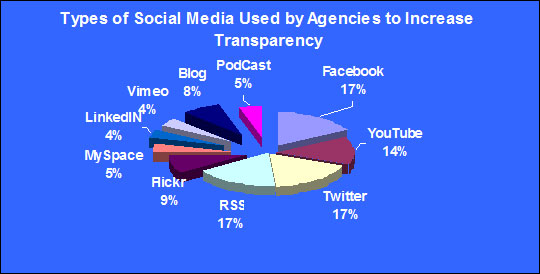
DOD is an example of an agency that provided a very detailed description of its social media activities. DOD maintains fifty active blogs and has a presence on eleven social networking sites. Many of its senior military leaders blog and twitter, including the Chairman of the Joint Chiefs of Staff who has over 15,000 followers on Twitter. The Department of the Interior, U.S. Geological Survey is developing a system to gather real-time information on earthquakes using Twitter. In another example of effective use of social media, the Consumer Product Safety Commission holds live webcasts of its public hearings and meetings, which allows the public to participate electronically.
Agencies should constantly be looking for new ways to be transparent. They should explore the full array of media available to them to increase their proactive disclosures of information. Given the many benefits of social media, their appeal to a new demographic of the public, and their ability to be updated quickly, social media are an important element of increased transparency.
Section IV: Steps Taken to Greater Utilize Technology
For this Section of agency Chief FOIA Officer Reports, OIP asked agencies to answer a series of eight questions related to their use of technology. This was the first time that an agency-wide survey of the use of technology to administer the FOIA had been taken. The results showed that overwhelmingly agencies are harnessing technology to assist in the basic elements of FOIA processing, i.e., receiving, tracking, and processing requests, and preparing Annual FOIA Reports. As mentioned above, when compiling statistics for those agencies that handle requests on a decentralized basis, the agency was counted as answering in the affirmative if a majority of its components responded in the affirmative.
A. Receiving Requests Electronically
First, agencies were asked to report whether they currently receive requests electronically and if not, what were the current impediments to doing so. Of the ninety-four Departments and agencies subject to the FOIA, eighty-nine reported that they receive requests electronically – an extraordinarily high percentage. Only five agencies reported that they did not receive requests electronically.
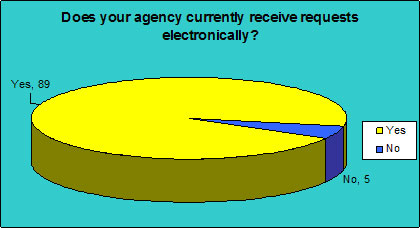
All cabinet agencies reported that they receive requests electronically. Although agencies were not asked to specify the method of receipt, for those that did specify, forty-seven reported that they received requests by e-mail and twenty-four reported receiving requests by electronic request form. Some agencies reported utilizing both methods. Three agencies reported that their electronic receipt of requests entailed merely receiving requests by fax.
Given the extraordinarily high number of agencies reporting that they receive requests electronically, there were only a few to which the second question was applicable. The second question in Section IV asked agencies to describe any impediments to establishing a mechanism to receive requests electronically. For those agencies that responded, the impediments cited were privacy concerns, technological impediments, a low volume of requests which obviated the need to receive requests electronically, and cost. Four agencies reported that they are in the process of implementing systems to receive requests electronically.
FINDINGS AND OIP GUIDANCE FOR IMPROVEMENT
Virtually all agencies already receive requests electronically, either by e-mail or through electronic request forms. Given this widespread use of technology to simplify the request-making process, during the next year those few agencies that do not receive requests electronically should consider doing so. Moreover, for all agencies that utilize a decentralized system to receive requests, the components that are not receiving requests electronically should expand so that the agency is able to report next year an increased capacity to receive requests electronically. Components within agencies that are already utilizing technology to receive requests should share their experiences and methods with those components that do not yet receive requests electronically to facilitate agency-wide implementation of this procedure which is quite beneficial to requesters.
B. Tracking Requests Electronically
Agencies were next asked to report whether they track requests electronically. Once again, there were an extraordinarily high number of affirmative answers. Eighty-six agencies reported that they track electronically, with only eight reporting that they do not.
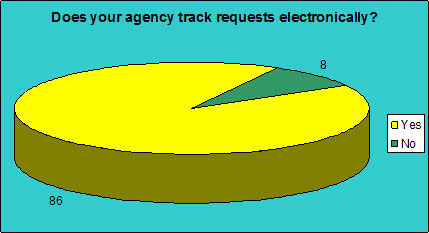
As with question two, for many agencies question four – which asked for any impediments to utilizing technology to track requests – was not applicable, given that most agencies do, in fact, use technology to track requests. For those agencies that responded, the impediments cited were cost and lack of need for electronic tracking. Three reported that they are in the process of implementing electronic tracking.
FINDINGS AND OIP GUIDANCE FOR IMPROVEMENT
As with receipt of requests electronically, virtually all agencies utilize some form of electronic FOIA request tracking system. There are obvious benefits to doing so, including increased efficiency and accuracy. Moreover, given that the FOIA requires agencies to provide requesters with information on the status of their request, it is vitally important that agencies have available to them a ready way to ascertain where a request is in the system. Thus, for those agencies that process on a decentralized basis, during the course of the next year, the capacity to track requests electronically should be expanded. For those few agencies not yet tracking electronically they should explore doing so.
C. Processing Requests Electronically
Question five asked agencies to report whether they utilize technology to process requests. Again, the response was overwhelmingly affirmative, with eighty-six agencies responding in the affirmative. Only eight agencies reported that they did not utilize technology to assist in processing requests.
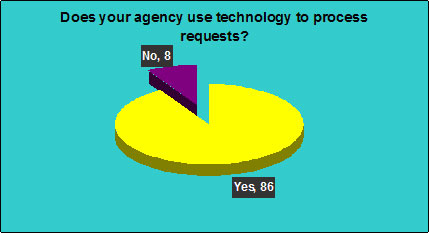
When asked to describe the impediments to using technology to process requests, for the few agencies for which this question was applicable, the impediments cited were cost effectiveness or lack of need and technological impediments. Four agencies reported that they were in the process of implementing technology-based tracking systems.
FINDINGS AND OIP GUIDANCE FOR IMPROVEMENT
Once again, agencies clearly realize the benefits of utilizing technology to process requests. The old days of using black pens and red tape to manually redact documents are a thing of the past. Still, for the decentralized agencies that do not universally employ technology to process requests, efforts should be made to ensure that the entire agency utilizes technology. Similarly, for those few agencies which still do not use technology to process requests, they should actively explore doing so.
D. Preparing Annual FOIA Reports Electronically
Question seven asked agencies whether they used technology to prepare their Annual FOIA Reports. Although the number was still quite significant, seventy-eight agencies reported doing so, this was slightly less than the number of agencies that otherwise use technology to receive, track, and process requests. Sixteen agencies reported that they did not use technology to prepare their Annual FOIA Reports.
For those agencies that reported the type of technology they used, there was a mixed response, with thirteen reporting that they used a FOIA-specific system and twenty-nine reporting that they used non-FOIA-specific technology like Excel or Word to prepare their Annual FOIA Reports. Technology can, of course, be used to improve an agency’s ability to provide reliable statistics for its Annual FOIA Report. For example, the CIA implemented several refinements to its system to add key data collection capabilities helpful to preparation of its Annual FOIA Report.
When asked to describe the impediments to using technology to prepare Annual FOIA Reports, agencies cited lack of need and cost. Seven agencies reported that they are in the process of implementing systems to utilize technology in preparation of their Annual FOIA Reports.
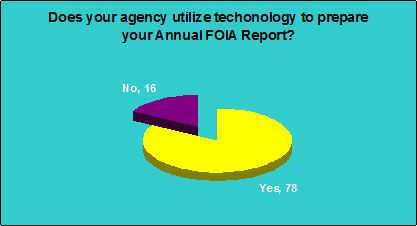
FINDINGS AND OIP GUIDANCE FOR IMPROVEMENT
Given the tremendous amount of highly-detailed data that must be collected by agencies to compile their Annual FOIA Reports, and given the need to be as accurate as possible in those Reports, those agencies, or components of agencies not currently utilizing technology to compile Annual FOIA Report statistics should take steps to do so within the next year.
E. Overall Conclusions on Agency Use of Technology
As shown above, OIP’s survey of agency use of technology revealed that rather than lacking in their utilization of technology for the basic elements of FOIA administration, agencies have in fact embraced technology to help them manage their FOIA workloads.
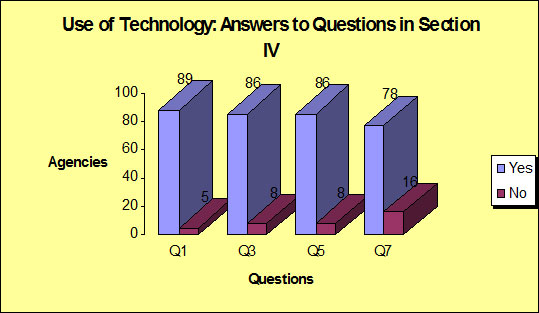
Nonetheless, there are two key areas where technology can be better utilized to achieve even greater gains in efficiency in FOIA administration.
FINDINGS AND OIP GUIDANCE FOR IMPROVEMENT
1. A key aspect of FOIA processing involves searching for records within the agency. In today’s workplace such searches frequently entail searching through voluminous numbers of e-mail messages and disparate records systems throughout the organization. Achieving real efficiency in FOIA processing will entail agencies maximizing their electronic record-keeping capacities to facilitate identification of the location of records responsive to requests. Requesters often assume that when they make a request for records on a given topic, the only thing the agency FOIA Office need do is type in the topic on an agency-wide or component-wide system, and all the records on that topic will be electronically identified and can then simply be printed out. While some systems of records are able to be searched that way, many are not, and achieving this efficiency in locating records will have a huge impact on FOIA processing time.
2. In managing their agency’s FOIA workload, it is vital that Chief FOIA Officers and other FOIA professionals have the ability to take snapshots of where the agency stands throughout the year. That way the Chief FOIA Officer will know during the course of the year such things, for example, as whether the agency or particular components of the agency are receiving far greater number of requests than is typical, and can adjust resources and personnel accordingly. Likewise, it is important for agencies to be able to monitor throughout the year the status of any backlog of FOIA requests, and the disposition of those requests that have been closed, such as the number of requests resulting in a release in full or a release in part. Agencies should have the capability to monitor their FOIA activity throughout the course of the fiscal year so that problems can be identified and corrected during the course of the year.
There are six key metrics that should be available to FOIA managers throughout the course of the year. These metrics are: 1) the number of requests received; 2) the number of requests processed; 3) the number of requests in the agency’s backlog; 4) the number of requests resulting in a release in full of the requested records; 5) the number of requests resulting in a release in part of the requested records; and 6) the number of requests where all requested records were withheld in full.
Section V: Steps Taken to Reduce Backlogs and Improve Timeliness in Responding to Requests
Both the President and the Attorney General emphasized the importance of improving timeliness in responding to FOIA requests. To assess agencies’ efforts in improving their response times, OIP asked each agency to report on three separate elements in Section V of their Chief FOIA Officer Report. First, agencies reported whether they were reducing their backlogs. This reduction was measured both in terms of the number of backlogged requests and administrative appeals that were pending at the end of Fiscal Year 2009 as compared with Fiscal Year 2008, as well as in terms of the age of those requests and appeals. If the number of pending requests or appeals did not decrease, agencies were then asked to describe why that has occurred and what they were doing to bring about a reduction. Lastly, agencies were asked to describe the steps they were taking to improve timeliness when responding to requests and administrative appeals.
A. Backlog Assessment – Number of Backlogged Requests
To create a complete picture of agencies' backlogs, OIP used two separate backlog measurements: the number of requests in any backlog and the ages of the oldest of those requests. First, OIP examined the status of agencies’ backlogs overall, looking at whether the number of backlogged requests and administrative appeals decreased from the end of Fiscal Year 2008 to the end of Fiscal Year 2009, as reported in Section XII of agency Annual FOIA Reports. Overall, the majority of agencies are making quite remarkable progress in this regard. Across the government significant reductions in the backlog have occurred. The overall backlog reduced dramatically from 133,295 requests in Fiscal Year 2008, to 77,377 backlogged requests in Fiscal Year 2009.
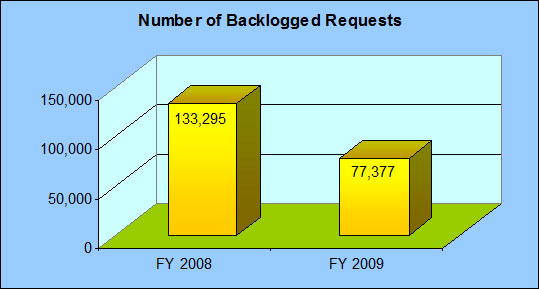
Fifty-five agencies, constituting almost two-thirds of all agencies, reported decreases in their backlogs for Fiscal Year 2009, or reported that they had no backlog at all for either year. Only thirty-six agencies, or roughly one-third, reported an increase in the number of requests in their backlog.
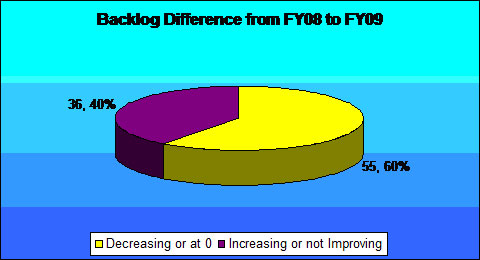
More specifically, the request backlog decreased for thirty-three agencies and remained at zero for twenty-two agencies. The request backlog increased or remained the same for only thirty-six agencies.
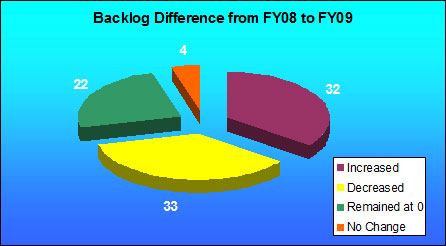
For the thirty-two agencies that reported increases in their backlogs, OIP found that twenty-one of those agencies had only minor increases in their backlog, totaling twenty-five requests or less. The remaining eleven agencies had increases in their request backlog that ranged from forty-two to 4,457.
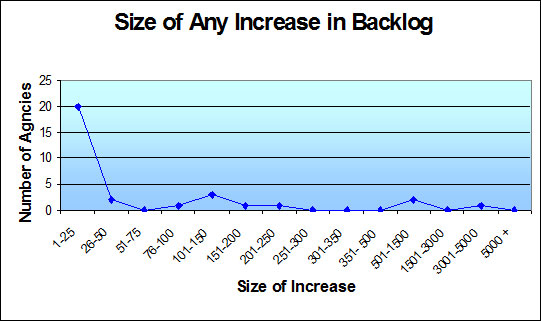
FINDINGS AND OIP GUIDANCE FOR IMPROVMENT
Agencies have made real, measurable progress in reducing their backlogs. Two-thirds of agencies either are reducing their backlog or have no backlog at all. Of those agencies with a backlog, only eleven reported that the backlog increased beyond twenty-five requests. While all thirty-two agencies that reported any increase in their backlog need to take additional steps to reverse that trend, it is a significant sign of success that so many agencies are moving in the right direction by reducing their backlog or by continuing to operate with no request backlog at all.
B. Decreases in Backlog
OIP next examined the agencies that reported decreases in their backlogs to assess the extent of their success in this area. For many of these agencies the progress is just beginning. Of the thirty-three agencies that had a decrease in their backlog, fifteen had a decrease of twenty-five requests or less. The remaining eighteen agencies, however, have made significant progress in backlog reduction. These agencies had decreases of up to 5,000 requests.
Of these, the following twelve agencies had decreases of over 100 requests: Department of Agriculture, HHS, DHS, HUD, DOT, Department of the Treasury, VA, CIA, EPA, Equal Employment Opportunity Commission, Legal Services Corporation, and the SEC. DHS -- which, while still having a sizable backlog, has been systematically reducing it -- reported that at the end of Fiscal Year 2009 it had a backlog of 18,787 requests, but as of January 2010 the backlog was reduced to 12,406 requests. HHS and VA also reported significant reductions in their backlogs, reducing them by 1891 and 1977 requests, respectively.

C. Backlog Assessment – Age of Oldest Request
Backlog reduction involves both reducing the number of backlogged requests and reducing the ages of the oldest of those requests. Overall, the data in agency Chief FOIA Officer Reports shows that agencies are continuing to improve the age of their oldest pending requests. Specifically, of the agencies with a backlog, fifty-one improved the age of the oldest request, while only fourteen did not make this improvement. Looked at as a matter of overall percentages, fifty-seven percent of all agencies improved the age of their oldest request, twenty-eight percent did not have a backlog in either Fiscal Year 2008 or 2009 and so had no need to improve, and the remaining fifteen percent of agencies failed to improve the age of their oldest request.
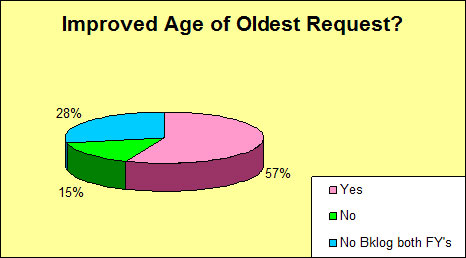
The need for uniform and continued attention to closing the oldest requests is most evident when the age of those oldest requests is examined. At the end of Fiscal Year 2009, roughly a third of the agencies with backlogs had received all of their pending requests within that fiscal year. The remaining two-thirds, however, had requests pending from previous fiscal years. Most notably, four agencies had requests still pending from the 1990's, going as far back as 1992. Additionally, the oldest requests at four other agencies were received ten years ago, in Fiscal Year 2000.
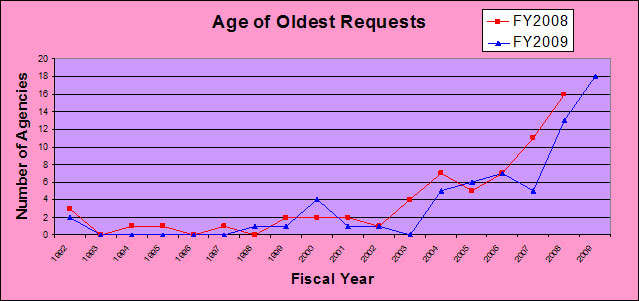
FINDINGS AND OIP GUIDANCE FOR IMPROVEMENT
Every agency should establish a goal of closing its ten oldest requests each fiscal year. While most agencies were able to report progress in this area and the closing of their oldest requests, the age of requests across the government continues to be too old. Chief FOIA Officers should work with their FOIA offices to make sure that the oldest requests are being monitored and that the appropriate resources are being applied directly to these more complex requests so that the oldest ten are closed each year.
D. Backlog Assessment – Number and Age of Administrative Appeals
Seventy-eight agencies reported a decrease in their administrative appeal backlog or did not have any backlogged appeals at the end of either fiscal year. Only fourteen agencies had an increase in their administrative appeal backlog and one agency reported that its appeal backlog remained the same for Fiscal Years 2008 and 2009. These statistics show that for the most part agencies have been able to adjudicate administrative appeals without acquiring a backlog or have begun to take steps to address any existing backlog they may have.
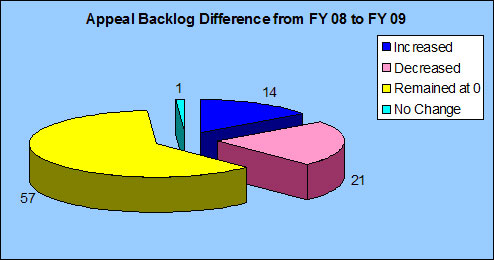
Further, the vast majority of agencies were able to reduce the age of the oldest pending appeal. Of the agencies with backlogged appeals, twenty-nine reduced the age of the oldest from Fiscal Year 2008 to Fiscal Year 2009, and only seven did not improve the age.

FINDINGS AND OIP GUIDANCE FOR IMPROVEMENT
As mentioned above in the context of requests, all agencies should continue to focus on closing their oldest appeals and should have as their goal the closing of the ten oldest administrative appeals each year.
E. Common Reasons for Backlogs
The challenges agencies experience in processing FOIA requests and keeping up with demand vary widely across the government. This is not unexpected, as the types of records maintained by agencies are often very different, the number of incoming requests varies greatly, and the size of FOIA offices, and number of personnel devoted to FOIA operations are all different. Still, for those agencies that reported having backlogs OIP identified four common reasons that were cited by those agencies as factors contributing to the backlog. Increases in backlog were commonly attributed to: 1) an increase in the number of incoming requests in Fiscal Year 2009; 2) departure of staff; 3) receipt of more complex requests than anticipated; and 4) competing priorities of the personnel responsible for handling FOIA matters, which limited their ability to devote more time to FOIA.
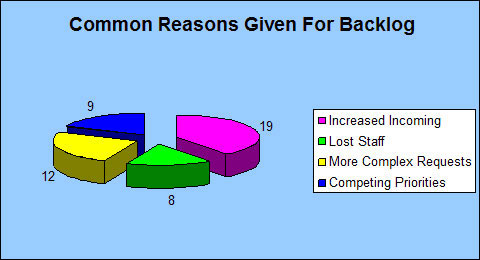
There were several examples of agencies reporting that an increase in the number of incoming requests caused an increase in the agency’s backlog. For example, NARA’s backlog increase of 1073 requests was attributed to the fact that it received 4506 additional requests in Fiscal Year 2009 as compared to Fiscal Year 2008.
Other agencies lost key personnel and consequently were not able to process as many requests as expected. For instance, when comparing Fiscal Year 2009 to Fiscal Year 2007, the Department of the Interior personnel devoted to FOIA operations decreased by seventeen percent. Such a loss can greatly impact small FOIA offices that only have a couple of people responsible for processing requests. This occurred at the Corporation for National Community Service, where its sole FOIA Disclosure Officer departed and that position took several months to fill.
Also, while agencies must prepare for receipt of a certain number of complex requests, twelve agencies reported that they had received unexpectedly complex requests and this fact contributed to their backlog. For instance, the U.S. Agency for International Development reported that it had an increase in complex requests that called for additional reviews and consultations. As a result, processing those requests required more resources than are typically used to close a larger number of requests.
Lastly, agency personnel often have other responsibilities that they must balance with their obligation to process FOIA requests in a timely fashion. Several agencies explained that in Fiscal Year 2009 these other responsibilities took more of their personnel's time and resources than is typical. These competing priorities can be other FOIA responsibilities or often the personnel tasked with processing requests have other non-FOIA related responsibilities that can take a large portion of their time. Agencies such as the VA and the Federal Election Commission for example, reported experiencing shifting resources in order to handle information security, e-discovery, and "the press of other business."
FINDINGS AND OIP GUIDANCE FOR IMPROVEMENT
Agency FOIA professionals should work closely with their Chief FOIA Officer to address the challenges that are causing backlogs at their agency. It is the Chief FOIA Officer who is charged with the responsibility of ensuring that each agency’s FOIA operations are properly staffed and funded. The Chief FOIA Officer can also assist in re-prioritizing projects to ensure that FOIA operations are given sufficient attention in the agency. Whenever possible, agencies should ensure that they dedicate a sufficient number of personnel solely to FOIA responsibilities.
F. Steps Taken to Address Backlogs
The Department of Justice asked those agencies that were not able to reduce their backlogs or improve the age of their oldest requests or appeals to provide the steps that were being taken to make improvements. A variety of steps were cited by agencies.
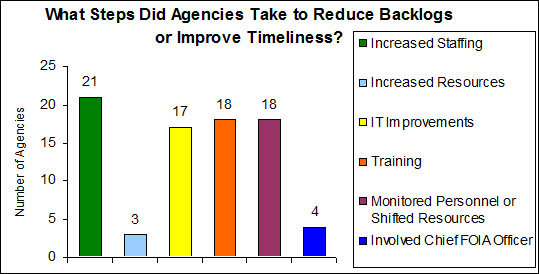
The most commonly cited remedial step was to increase the number of staff devoted to FOIA processing. Some agencies, including the National Transportation Safety Board, increased the number of people working with the FOIA on a temporary or part-time basis, such as increasing contractor support, while other agencies, including the FDIC, increased the number of employees working with FOIA on a full-time basis. The Federal Reserve System nearly doubled the resources directed to FOIA operations. An additional three agencies reported plans to increase the resources that are available to their staff working with the FOIA.
Similarly, some agencies have specifically devoted resources to making IT improvements to their FOIA processing systems. Many agencies have improved their ability to track requests. Others have used IT to improve their ability to process documents in a more efficient manner.
Several agencies did not increase their resources or staff, but instead have changed their current processing system by monitoring the requests more closely or shifting existing resources to focus on reducing their backlog. For example, the Legal Services Corporation temporarily shifted responsibilities within the office, allowing the FOIA Officer to devote her full time and attention to reducing the backlog of FOIA requests. Similarly, the SSA has realigned responsibility for routine cases, allowing more experienced staff to concentrate on the more complex backlogged cases.
Many agencies are addressing their backlog by using training to improve their processing systems. For example, DOD had over 1000 DOD personnel attend training and the Department of Energy will provide ongoing training to employees who process requests and specialized training will be provided to employees with newly delegated FOIA responsibilities.
Lastly, as was discussed above, several agencies have reported that their Chief FOIA Officer has become more involved in overseeing the agency’s capacity to process requests. By applying high level attention within the agency to the issue of backlogs, these agencies are highlighting the need for all agency personnel to do their part to help close requests that have been pending for too long. For example, GSA has reported that it provides a weekly FOIA report to the Chief FOIA Officer detailing all overdue FOIA requests, ensuring there is high-level attention paid to the requests that are pending the longest at that agency.
FINDINGS AND OIP GUIDANCE FOR IMPROVEMENT
While agencies across the government are moving in the right direction by reducing their backlogs of requests, in some cases quite dramatically, those agencies that are not seeing reductions will need to take action in order to turn the tide on backlogs. While each agency must examine its own system and capacities in devising approaches that will work, all agencies should ensure that sufficient resources are being devoted to FOIA administration at their agency and that sufficient training on the new presumption of openness is being provided. These are key responsibilities of each agency’s Chief FOIA Officer and were the subject of a memorandum to agency heads sent March 16, 2010, from the White House Chief of Staff and Counsel to the President. See http://www.whitehouse.gov/sites/default/files/rss_viewer/foia_memo_3-16-10.pdf Beyond ensuring that adequate resources and training are provided, agencies should set goals and monitor progress throughout the year so that they can achieve meaningful backlog reduction.
Conclusion
As can be seen from this summary, agencies across the government have undertaken a wide variety of steps to implement the President’s FOIA Memorandum and the Attorney General’s FOIA Guidelines. There are numerous outstanding examples of agencies applying the presumption of openness, ensuring that their FOIA systems are effective, improving their proactive disclosures, utilizing technology, and reducing backlogs. Concrete steps have been taken and real progress has been achieved in creating greater transparency.
At the same time, however, additional work remains to be done. This report provides guidance to agencies on the corrective steps that should be taken by agencies to ensure that all aspects of their FOIA operations are fully aligned with the President’s and Attorney General’s vision of making this the most transparent Administration in history.
OIP is available to assist agencies in any aspect of their work to achieve even greater transparency. OIP has also compiled a list of Best Practices to assist agencies in implementing improvements in each of the five distinct areas encompassed by the President’s FOIA Memorandum and the Attorney General’s FOIA Guidelines. As agencies continue their work to further implement the President’s FOIA Memorandum and the Attorney General’s FOIA Guidelines even greater transparency will be achieved in the year ahead. (posted 07/29/2010)
Last Updated: Thursday, July 29, 2010





